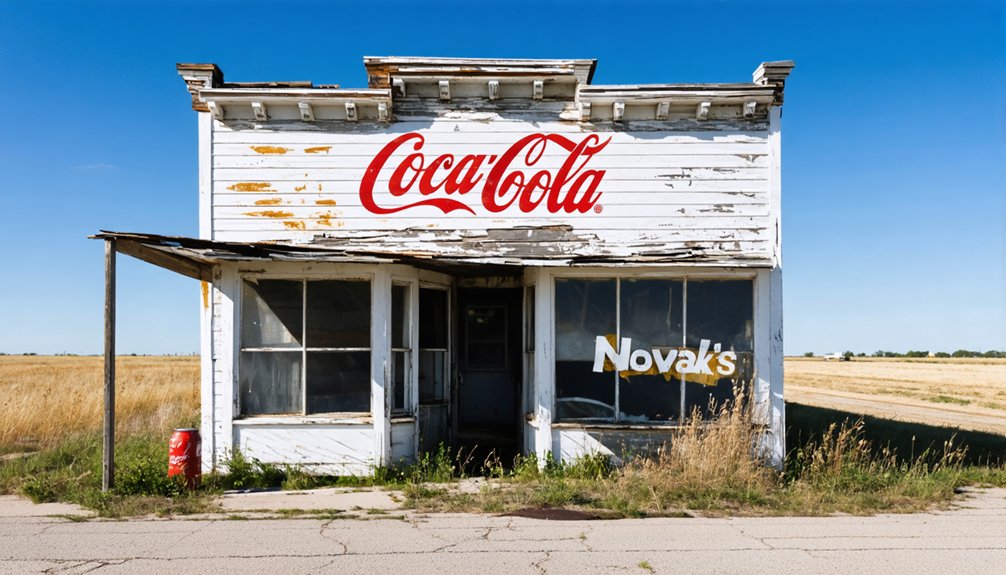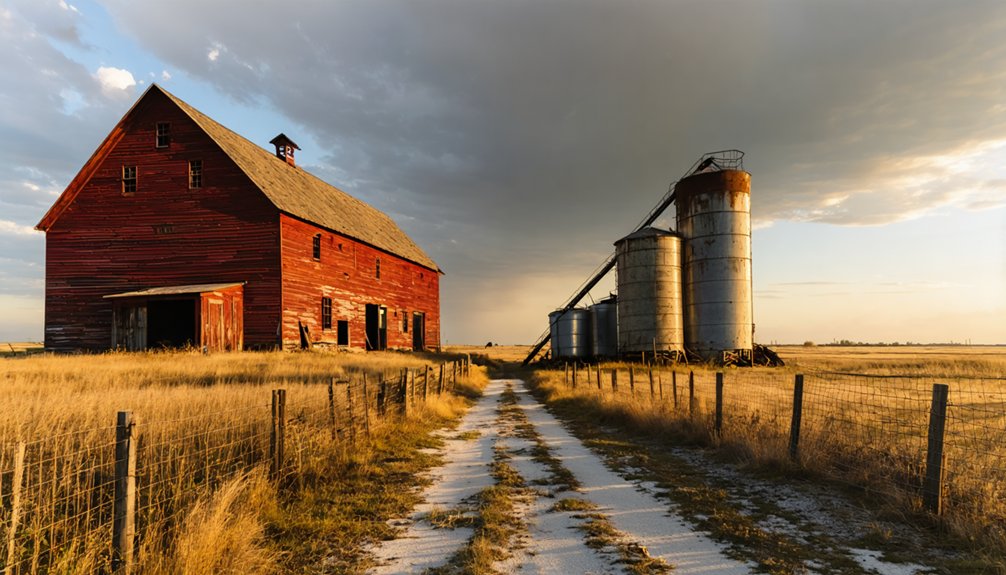You’ll find Novak nestled in Lawrence County’s Black Hills, where it once thrived as a mining community until the early 2000s. The town’s peak centered around gold mining operations, with a workforce of 2,200 that dwindled as operational costs rose and global competition increased. Today, only scattered remnants remain, including foundations of old farmhouses and industrial buildings. The town’s rich history of mining heritage and community life holds many untold stories.
Key Takeaways
- Novak was a mining town in Lawrence County’s Black Hills that experienced its peak during active mining operations.
- The town’s decline accelerated when railroad activity ceased and mining operations closed due to rising costs and global competition.
- By 1974, only two structures remained in Novak, marking its transformation from a bustling community to a ghost town.
- The community once supported 2,200 workers but collapsed in the early 2000s when gold mining became unprofitable.
- Historical records, including Watson Parker’s notebooks and archaeological surveys, document Novak’s transition from mining town to abandonment.
Origins and Early Settlement
While the exact founding date of Novak remains undocumented, this South Dakota ghost town‘s early settlement likely emerged from the region’s agricultural or mining activities.
The patient search for records involved in ghost town hunting makes tracing Novak’s exact origins challenging.
You’ll find that settlement patterns in the area were influenced by the availability of natural resources and proximity to transportation routes, which proved essential for the town’s establishment.
The presence of original houses suggests that Novak once supported a small but established community.
Similar to places like Blabon, North Dakota, which had a peak population of 150, Novak likely experienced its own period of modest growth.
Resource availability would’ve played a key role in attracting early settlers, though specific details about these economic activities aren’t well-documented.
You can discover traces of the town’s history through Watson Parker’s notebooks and other archival records, which provide glimpses into the lives of those who first called Novak home.
Life in Novak’s Peak Years
Although exact population figures remain elusive, Novak’s peak years centered around its mining operations in Lawrence County’s Black Hills region. You’d have found a bustling community of miners, merchants, and laborers, with seasonal migrations affecting the camp’s size throughout the year. Like nearby town Capa at 300, Novak saw its greatest population during its most prosperous period.
Daily life revolved around the mines, where your earnings would’ve depended on ore quality and market prices. You’d have lived in simple wood-frame structures or tents, hauling water from nearby sources and enduring harsh Black Hills winters.
Community dynamics centered on gathering spots like saloons and general stores, where you’d find entertainment through gambling, music, and storytelling. Without formal institutions, you’d have relied on nearby towns for essential services, creating a rugged, independent lifestyle typical of Black Hills mining camps. Similar to Mystic’s historic trail, many remnants of these old mining operations are still visible today.
The Railroad’s Impact
The arrival of railroads in the Black Hills region during the late 1870s and early 1880s reshaped Novak’s mining economy.
You’ll find the railroad influence reflected in both transportation efficiency and community dynamics, as the town adapted to embrace this revolutionary change in infrastructure. Many communities underwent last-minute relocations to align with proposed rail routes.
- The Black Hills and Fort Pierre Railroad’s merger with CB&Q in 1901 enhanced access to mining equipment and materials.
- Narrow gauge railways connected Novak to essential mining centers like Lead and Deadwood.
- The innovative third rail system allowed standard gauge equipment to reach the northern Black Hills operations.
- Railroad depots served as critical communication hubs, handling mail and telegrams that kept Novak connected to the outside world.
The railroad transformed Novak from an isolated mining settlement into a connected hub of regional commerce. The local railroads operated a mix of Porter 2-6-0 locomotives that hauled ore and supplies throughout the region.
Notable Buildings and Structures
Standing silently in South Dakota’s landscape, only two structures remained in Novak by 1974, marking what was once a bustling mining community.
While the specific buildings haven’t been documented, you’ll find that historic preservation efforts in similar South Dakota ghost towns typically focus on churches, community halls, and grain elevators due to their architectural significance.
Churches, community halls, and grain elevators often remain standing in South Dakota ghost towns, preserved for their historic importance.
Sites like these often feature no trace of civilization as nature gradually reclaims the land.
You might encounter foundations of old farmhouses, industrial buildings, or the town’s school, though they’re likely in various states of decay.
Similar to Owanka’s decline after the railroad stopped hauling water in 1935, many South Dakota ghost towns faced abandonment when vital infrastructure services ceased.
If you’re exploring, remember that some structures may be on private property.
Like other regional ghost towns, Novak’s remaining buildings tell stories of religious gatherings, community events, and agricultural activities through their weathered walls and crumbling facades, even as they continue to deteriorate without formal preservation efforts.
Economic Forces Behind the Decline
Like many Black Hills settlements, Novak’s decline accelerated when railroad activity dwindled, severing crucial transportation links for cattle shipping and commerce.
Similar to the mining town of Tinton’s 300 residents, Novak’s population steadily decreased as economic opportunities vanished. Agricultural employment shrank as ranches consolidated and drought conditions made farming less viable in the region. The harsh weather conditions that early settlers endured continued to challenge the sustainability of farming operations into modern times.
The closure of local mining operations, which had anchored the town’s early economy, eliminated the remaining industrial jobs and triggered an exodus of working families.
Railroad Activity Diminishes
During the mid-twentieth century, Novak’s railroad activity steadily diminished as multiple economic forces converged to reshape South Dakota’s transportation landscape.
You’ll recognize this transportation evolution as part of a broader pattern that affected many small towns across the state, stirring railroad nostalgia among longtime residents.
- The rise of automobiles in the 1950s led to the retirement of most passenger services, fundamentally altering how you’d travel through the region.
- Widespread abandonment of rail lines occurred throughout the 1960s and 70s as economic viability declined.
- Agricultural downturns and severe droughts reduced the demand for rail transport.
- Technological advances in trucking made rail transportation less competitive, forcing many lines to close.
These changes reflected the harsh economic realities that would ultimately transform Novak’s future.
Agricultural Jobs Vanish
As agricultural mechanization swept through South Dakota in the mid-twentieth century, Novak’s farming community underwent dramatic changes that would forever alter its economic landscape.
You’d have witnessed tractors and modern machinery replacing manual labor, leading to severe job scarcity across the region. While these technological advances allowed farmers to manage larger plots – with average farm sizes jumping from 438 to 545 acres between 1930 and 1940 – the mechanization effects devastated the local workforce.
Despite government attempts to stabilize farm incomes through New Deal programs and subsidies, Novak couldn’t escape the broader economic forces at play. The shift toward larger, more efficient farming operations meant fewer workers were needed, and many families who’d relied on agricultural employment were forced to seek opportunities elsewhere.
Mining Operations Cease
While gold mining had sustained Novak’s economy for generations, the industry’s collapse in the early 2000s dealt the town its final devastating blow.
You’ll find that several economic forces converged to make mining technology investments and economic sustainability impossible in Novak. The once-mighty Homestake Mine, North America’s largest, couldn’t survive against mounting challenges.
- Rising operational costs collided with fluctuating gold prices, making profitable extraction increasingly difficult.
- Underground structural issues caused dangerous surface subsidence, threatening the town’s buildings.
- Competition from lower-cost mines globally outpaced Novak’s aging operations.
- Stricter environmental regulations and remediation requirements added unsustainable financial burdens.
The workforce shrank from 2,200 to nearly zero, triggering a mass exodus as families sought opportunities elsewhere.
Without its economic backbone, Novak’s decline became inevitable.
Daily Life and Social History

Life in Novak revolved around the rhythms of resource extraction and railroad activity, with residents building their community despite the town’s modest size of fewer than 100 people.
You’d find community gatherings centered around the local church and post office, where neighbors shared news and supported each other through harsh weather and health challenges.
Daily struggles included coping with isolation, especially after the railroads ceased operations, while maintaining homes built from local materials.
The townspeople adapted to their circumstances through subsistence farming and small-scale commerce.
They created a tight-knit social fabric through seasonal celebrations and religious observances.
Even as essential businesses like the sawmill closed in the early 1950s, some residents persisted, maintaining their homes and preserving the town’s stories through oral histories.
Natural Elements and Geography
The rugged terrain of Lawrence County shaped Novak’s development within the Black Hills region.
You’ll find this ghost town nestled among ponderosa pine forests and rocky outcrops, where geological formations once promised mining riches. At an elevation between 4,000 and 6,000 feet, the site reflects the challenging environment early settlers faced.
- Natural disasters, including severe thunderstorms and occasional tornadoes, tested the town’s resilience.
- Continental climate brings dramatic seasonal changes, with snowy winters and warm summers.
- Local streams and creeks, part of the Black Hills watershed, provided essential water resources.
- Rocky clay loam soil supports diverse wildlife, including deer and elk, while limiting agricultural potential.
The landscape you’ll encounter today shows nature’s reclamation, as erosion and forest growth gradually obscure remnants of the former mining community.
Historical Documentation and Records

You’ll find limited census data for Novak in the official records, as the town’s population figures weren’t consistently tracked through formal government documentation.
The most concrete historical record comes from the establishment of Novak’s post office in 1907, which serves as a key milestone in confirming the town’s status as an organized settlement.
While exact population numbers remain elusive, town records indicate Novak’s presence as an active mining camp in Lawrence County before its eventual abandonment and transformation into a ghost town.
Census and Population Data
Dramatic population shifts in South Dakota’s rural regions have been well-documented through census records, with Novak serving as a stark example of the state’s ghost town phenomenon.
You’ll find census accuracy has been particularly challenging in tracking population dynamics of small communities like Novak, where dramatic decline led to complete abandonment.
- By 1974, Novak’s population had dwindled to virtually zero, with only two buildings remaining in what was once a bustling railroad shipping point.
- The town’s decline mirrors broader rural depopulation trends, as 64% of South Dakota’s residents now concentrate in just ten counties.
- Census records from 1890 onward show the gradual shift away from rural communities like Novak.
- Modern census data classifies Novak among the nearly 20% of U.S. ghost towns located in South Dakota.
Town Records Over Time
While piecing together Novak’s history presents challenges, multiple documentary sources help paint a picture of this former Black Hills settlement.
You’ll find the town’s earliest appearances on late 19th-century maps, though it’s sometimes listed under its alternate name, Cindell Spur. The establishment of a post office marks a significant point in Novak’s historical timeline, officially recognizing it as a legitimate settlement.
Local newspapers provide glimpses into the town’s demographics through reports of mining activity, business operations, and social events.
The 1918-1919 influenza pandemic records and obituaries reveal details about Novak’s residents.
Watson Parker’s 1991 ghost town notebooks, along with archaeological surveys and field reports, document the physical remains of structures, while government records, including land deeds and mining claims, verify the town’s economic activities.
Ghost Town Tourism Potential
Numerous economic opportunities await development in Novak, South Dakota’s potential as a ghost town tourist destination.
You’ll find that ghost town tourism can revitalize the local economy through strategic investments and visitor engagement. The town’s authentic historical value creates a compelling draw for diverse tourist segments, from history enthusiasts to adventure seekers.
- You can experience hands-on history through guided tours and interactive educational exhibits.
- You’ll discover new local businesses emerging, including cafes and gift shops, supporting economic revitalization.
- You can participate in seasonal events like historical reenactments and ghost tours.
- You’ll benefit from improved infrastructure as tourism development enhances roads and digital connectivity.
With proper development of visitor amenities and marketing strategies, Novak’s transformation into a tourist destination can strengthen both local economy and cultural preservation efforts.
Preservation and Legacy
Beyond its tourism potential, Novak’s lasting impact on South Dakota’s heritage deserves careful attention and preservation.
You’ll find that this former mining town, which flourished briefly in the early 1900s, represents a vital chapter in the state’s economic history. While formal preservation efforts are limited, the town’s historical significance lives on through scattered documentation and local stories.
Novak’s brief mining heyday in the early 1900s illuminates South Dakota’s economic past through scattered records and community tales.
The remaining structures and mining remnants stand as silent witnesses to the community’s boom-and-bust cycle.
Though community engagement in preservation is minimal, you can still explore the town’s physical remnants, which offer valuable insights into early 20th-century mining life.
Novak’s legacy endures primarily through historical texts, photographs, and the broader narrative of South Dakota’s mining heritage, despite the challenges of maintaining ghost town sites.
Frequently Asked Questions
Are There Any Reported Ghost Sightings or Paranormal Activities in Novak?
Unlike Deadwood’s spooky Bullock Hotel, you won’t find documented ghost experiences or haunted locations in Novak. Historical records and local sources don’t mention any paranormal activity in this former mining town.
What Happened to the Residents’ Personal Belongings When They Abandoned Novak?
You’ll find abandoned artifacts scattered throughout deteriorating buildings, while some belongings were taken by departing families, scavenged by visitors, or destroyed by weather. Personal histories vanished as items decayed or disappeared.
Did Any Famous People or Notorious Criminals Ever Live in Novak?
You won’t find records of any famous residents or notorious events in Novak’s history. The quiet mining town focused on family life, with its school and homes, rather than attracting notable personalities.
Were There Any Major Disasters or Tragedies That Contributed to Novak’s Abandonment?
You won’t find any significant natural disasters in Novak’s history. Instead, the town’s fate was sealed by economic decline when mining operations dwindled and jobs disappeared, causing residents to seek opportunities elsewhere.
Does Anyone Still Own Property or Pay Taxes in Novak Today?
You’d be surprised, but there’s no active property ownership or tax responsibilities in Novak today. The ghost town’s properties lack current documented owners and generate no taxable revenue.
References
- https://www.sdpb.org/rural-life-and-history/2023-08-21/some-black-hills-ghost-towns-and-their-origins
- https://www.youtube.com/watch?v=_0WNYsFLSLA
- https://www.youtube.com/watch?v=Glucs_Rq8Xs
- https://www.powderhouselodge.com/black-hills-attractions/fun-attractions/ghost-towns-of-western-south-dakota/
- https://www.sdhspress.com/journal/south-dakota-history-2-2/some-black-hills-ghost-towns-and-their-origins/vol-02-no-2-some-black-hills-ghost-towns-and-their-origins.pdf
- https://icatchshadows.com/okaton-and-cottonwood-a-photographic-visit-to-two-south-dakota-ghost-towns/
- https://en.wikipedia.org/wiki/List_of_ghost_towns_in_South_Dakota
- https://explore.digitalsd.org/digital/collection/WPGhosttown/id/5229/
- https://b1027.com/south-dakota-has-an-abundance-of-ghost-towns/
- https://ghostsofnorthdakota892857007.wordpress.com/2017/03/28/the-story-of-how-ghosts-of-north-dakota-began/



